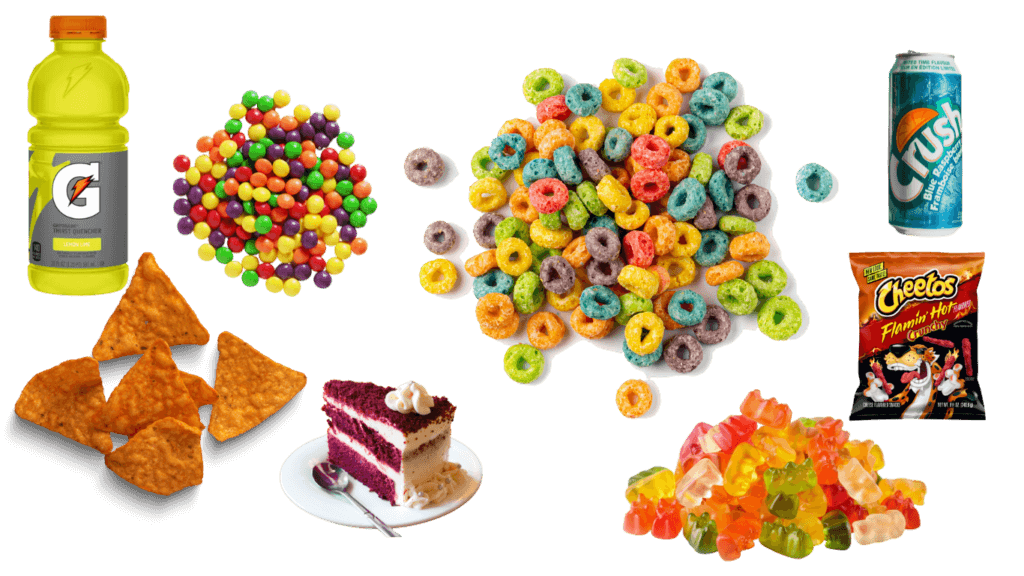For decades, we’ve enjoyed munching on these eye-catching snacks and treats, featuring bright red cereals, neon green sodas, and colorful candies.
But all these iconic colored snacks are about to look very different thanks to a sweeping FDA decision to phase out synthetic food dyes.
If you’re a parent reading labels, a health-conscious consumer concerned about what goes into your snacks, or a food industry professional preparing for change, this is news you can’t ignore. Here’s what’s changing, why, and what to watch for in your favorite foods.
What Is the Food Dye Ban and Why Now?
The Food and Drug Administration (FDA) is officially phasing out all petroleum-based synthetic food dyes by the end of next year (Office, 2025).
This includes commonly used additives like Red Dye 40, Yellow Dye 5 and 6, Blue Dye 1 and 2, and Green Dye 2. Red Dye 3, already on the way out, is getting an accelerated deadline.
Why the ban?
- Decades of concern have built up over the safety of these artificial colorants, with recent studies showing potential links to increased hyperactivity in children (Kanarek, 2011).
- Many health advocates and parents have long called for action on dyes, pointing to their reputation as “toxic soup” and links to behavioral and health issues (Halpert, 2025).
- Regulatory trends abroad have been stricter for years, with many countries already using natural alternatives in products that look identical to American versions.
- The FDA’s current attitude is clear, per Commissioner Marty Makary: “Taking petroleum-based food dyes out of the food supply is not a silver bullet…but it is one important step.”
Which Popular Snacks and Foods Are Most Affected?
The artificial color ban will directly impact food manufacturing giants like PepsiCo, General Mills, Mars, and Kellogg.
Many of their best-selling products depend on artificial dyes for their signature looks.
Here are some snacks headed for ingredient overhauls:
Colorful Candies

- Skittles (Mars): The rainbow of colors comes from synthetic dyes, especially Red 40 and Yellow 5. Expect muted shades if natural alternatives replace them.
- M&Ms and Starburst (Mars): Bright hues are at risk, though the company has experience using natural colors in the UK and EU.
Bold-flavored chips and Savory Snacks

- Flamin’ Hot Cheetos (PepsiCo/Frito-Lay): Neon red dust? That’s Red 40 and Yellow 6. The fiery color will need a different approach.
- Doritos (PepsiCo): From Nacho Cheese orange to Cool Ranch blue, almost every flavor uses synthetic colorants.
- General Mills Cereals (Trix, Froot Loops, Lucky Charms): Petroleum-based dyes give each piece of cereal its personality.
Brightly Colored Sodas and Sports Drinks
- Mountain Dew Baja Blast (PepsiCo): That signature electric teal comes from a mix of Blue and Yellow dyes.
- Powerade, Gatorade, and similar drinks (various manufacturers): Each flavor relies on a distinct color.
Breakfast Cereals
- Froot Loops (Kellogg), Trix, and Lucky Charms (General Mills): All depend on Red 40, Yellow 5, 6, and Blue 1 to separate one “fruit” from another.
Other Everyday Snacks
- Pop-Tarts (Kellogg): Frosted and filled varieties use artificial dyes for both the icing and the sprinkles.
- Snack Cakes, Iced Cookies, and Pastries (Little Debbie, Hostess, store brands, etc.): Dyes pop up throughout the treat aisle.
Fast Food and Restaurant Fare
- Milkshakes, Sundaes, and Slushies from national chains, as well as brightly colored sauces or toppings, routinely rely on synthetic colorants.
Quick Fact: The FDA plans to set a “national standard” and timeline for the transition to natural coloring alternatives and will approve new natural color additives to help manufacturers keep food visually appealing (Lucas & Constantino, 2025).
How Will This Impact Shoppers, Kids, and Brands?
For Parents & Kids
- Health First: The shift could reduce artificial exposure for growing children. Concerns about hyperactivity and behavior, long linked (however controversially) to synthetic dyes, have fueled parent-driven campaigns for years.
- Taste & Acceptance: This isn’t the first time companies have tried swapping dyes. When General Mills reformulated Trix with natural colors, some parents welcomed it, but many kids rejected the less-vivid version. (Trix eventually brought back the artificial hues.)
- Allergen & Dietary Impacts: While natural dyes like beet, carrot, or watermelon juice are generally considered safe, they introduce new allergens for a small subset of people. Manufacturers must update their labels and warnings carefully.
For Health-Conscious Consumers
- More Transparency: This move aligns with the real food trend, which values shorter, more recognizable ingredient lists.
- Price Changes: The FDA says a price spike isn’t expected; however, natural colors are often pricier to produce and require more volume to achieve the same vibrancy as synthetics. Consumers could see small price hikes or treat sizes shrink in some cases.
- Potential for ‘Cleaner’ Snacks: The ban will push brands toward simpler recipes and allow consumers more choice in what ingredients end up on shelves.
For Food Industry Professionals
- Recipe Overhauls: Reformulation is no small effort. Some dyes will be easier to swap than others, but iconic products risk losing their unique “look.”
- Supply Chain Adjustments: Brands will need new sources of ingredients like beet juice, spirulina, carrot extract, and turmeric to achieve vivid colors.
- Marketing Strategy: Expect new product launches and revamped packaging. Companies may lean into the narrative of “naturally colored,” “dye-free,” or “new look, same taste.”
- Customer Feedback: If history repeats itself (as with Trix), some reformulated products could face fan backlash. The opportunity is there for better health marketing, but clarity and honesty will be essential.
International Insights
Countries like the UK and members of the EU have long prohibited or limited the use of food dyes that Americans still see daily.
Companies such as Kraft Heinz and Mars already use natural colors in European versions of products popular in the US, proving it’s possible to make these changes.
The challenge, of course, is that natural alternatives look different.
What’s Next for Companies and Consumers?
New Ingredients on the Horizon
- The FDA recommends watermelon, beet, and carrot juices as alternatives to red and yellow petroleum-based dyes.
- The agency plans to authorize four new natural color additives, with approval for more options fast-tracked.
- Ingredient manufacturers (like McCormick) are seeing increased demand from brands looking to reformulate.
Enforcement and Timeline
- The FDA and food companies have an “understanding” of the phaseout rather than a formal agreement. Tools for enforcement are being explored, but right now, the agency is encouraging voluntary compliance.
- Official deadlines have been set for most dyes to the end of next year, with Red Dye 3 getting a particularly short timeline.
How Products Will Look
Shelf aesthetics are set to change:
- Expect less neon, more muted or pastel tones, and less visually “loud” snack packaging.
- Retro packaging and “throwback” campaigns may pop up, tapping into nostalgia while shifting the focus away from color.
- Clear labeling and new allergy information will need to be front and center.
Brands Taking Initiative
Kraft Heinz was ahead of the curve, switching its mac & cheese to natural dyes for the US market in 2015.
Not all efforts have succeeded, but modern consumers are more accepting of duller, natural-looking foods if health is the trade-off.
What Can You Do?
- For Parents: Talk to your kids about why their favorite snacks might not “pop” visually soon but assure them it’s for their well-being.
- For Health-Minded Shoppers: Seek out snack brands already using natural dyes or “clean label” claims.
- For Industry Professionals: Explore innovative sourcing and labeling. Highlight the health story and reformulation process in your marketing. Engage consumers early with samples or taste tests to ensure the new versions find their audience.
Turning Food Color Reform Into Health Opportunity
The dye ban marks a pivotal moment for America’s food culture.
For decades, synthetic colors have not only defined what snacks look like but also shaped our perceptions of flavor, freshness, and fun. Now, health and safety concerns are shifting that landscape.
This change brings some uncertainty, especially when familiar foods look (and maybe even taste) different.
But many global markets have already shown that these adjustments can succeed when paired with consumer education and clever innovation.
Parents, consumers, and brands now stand at the edge of a more transparent and health-forward snack era.
Choose products that align with your values, use this as a conversation starter about food labels and health, and watch closely as your favorite candies and cereals undergo their biggest glow-down yet.
For a detailed look into artificial dyes in food, please read https://grosseating.com/the-use-of-artificial-colors-in-our-food-supply/ and https://grosseating.com/artificial-red-color-40-banned-in-the-u-s/.




